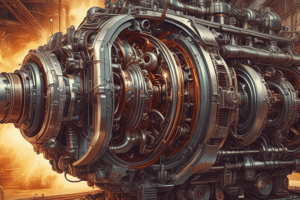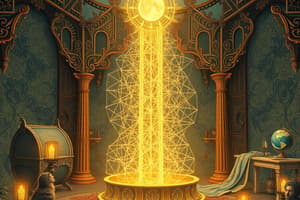Podcast
Questions and Answers
What is the Physics definition of 'work'?
What is the Physics definition of 'work'?
Work happens whenever things are moved or rearranged by force.
How is energy defined in Physics?
How is energy defined in Physics?
Energy is the ability to do work.
Which of the following has the energy to lift a pile of bricks using a pulley?
Which of the following has the energy to lift a pile of bricks using a pulley?
- The bricks
- A person using the pulley (correct)
- Gravity
- The pulley itself
What happens to energy in the Jack-in-the-box?
What happens to energy in the Jack-in-the-box?
What is the formula for calculating Kinetic Energy?
What is the formula for calculating Kinetic Energy?
What does GPE stand for?
What does GPE stand for?
What is the Law of Conservation of Energy?
What is the Law of Conservation of Energy?
How is Elastic Potential Energy calculated?
How is Elastic Potential Energy calculated?
Energy is measured in _____ (J).
Energy is measured in _____ (J).
What conversion occurs when an electric light is turned on?
What conversion occurs when an electric light is turned on?
Flashcards are hidden until you start studying
Study Notes
Work
- Work occurs when an object is moved or rearranged by an applied force.
- Work is defined as a scalar quantity, calculated using the formula: Work (W) = Force (F) x Distance (d) or W = F x d.
Energy
- Energy is the ability to do work and is measured in joules (J).
- Energy causes movement, combustion, and the production of light and sound.
- Energy is not directly visible, but its effects can be observed.
Types of Energy with Examples
- Bricks and Pulley: The person pulling the bricks has the energy to lift them.
- Rock and Explosive: The explosive material possesses the energy to break the rock.
- Jack in the Box: The compressed spring holds elastic potential energy that transforms into kinetic energy when released.
- Windmill: Wind has kinetic energy that turns the vanes.
- Light Globe: The battery provides electrical energy that is converted into light.
Energy Transformation
- Energy can change from one form to another:
- In a jack-in-the-box: Elastic Potential Energy → Kinetic Energy.
- Electric light: Electrical Energy → Light Energy.
- Hammering a nail: Kinetic Energy → Heat Energy.
Energy Converters
- Examples of energy conversion:
- Chemical to Kinetic.
- Electrical to Thermal.
- Chemical to Electrical.
- Electrical to Radiated.
- Electrical to Sound.
Types of Energy Focus
- Kinetic Energy (KE): The energy of moving objects, calculated by KE = ½ x mass (m) x speed (v)².
- Gravitational Potential Energy (GPE): Energy based on an object's position in a gravitational field, calculated by GPE = mass (m) x gravitational field strength (g) x height (h).
- Gravitational field strength (g) = 9.8 N/kg.
- Elastic Potential Energy (EPE): Energy in stretched or compressed objects, represented as EPE = ½ x spring constant (k) x extension/compression (e)².
Example of Kinetic Energy Calculation
- For a car with mass 1400 kg traveling at 40 km/hr:
- Convert speed to m/s: 40 km/h = 11.1 m/s.
- Calculate KE: KE = ½ x 1400 x (11.1)² = 86,247 J (or 86 kJ).
- If the car travels at 80 km/h, the kinetic energy increases to 344,988 J (or 345 kJ), highlighting that KE is proportional to the square of speed.
Law of Conservation of Energy
- The total energy in an isolated system remains constant; energy cannot be created or destroyed, only transformed from one form to another.
Studying That Suits You
Use AI to generate personalized quizzes and flashcards to suit your learning preferences.





